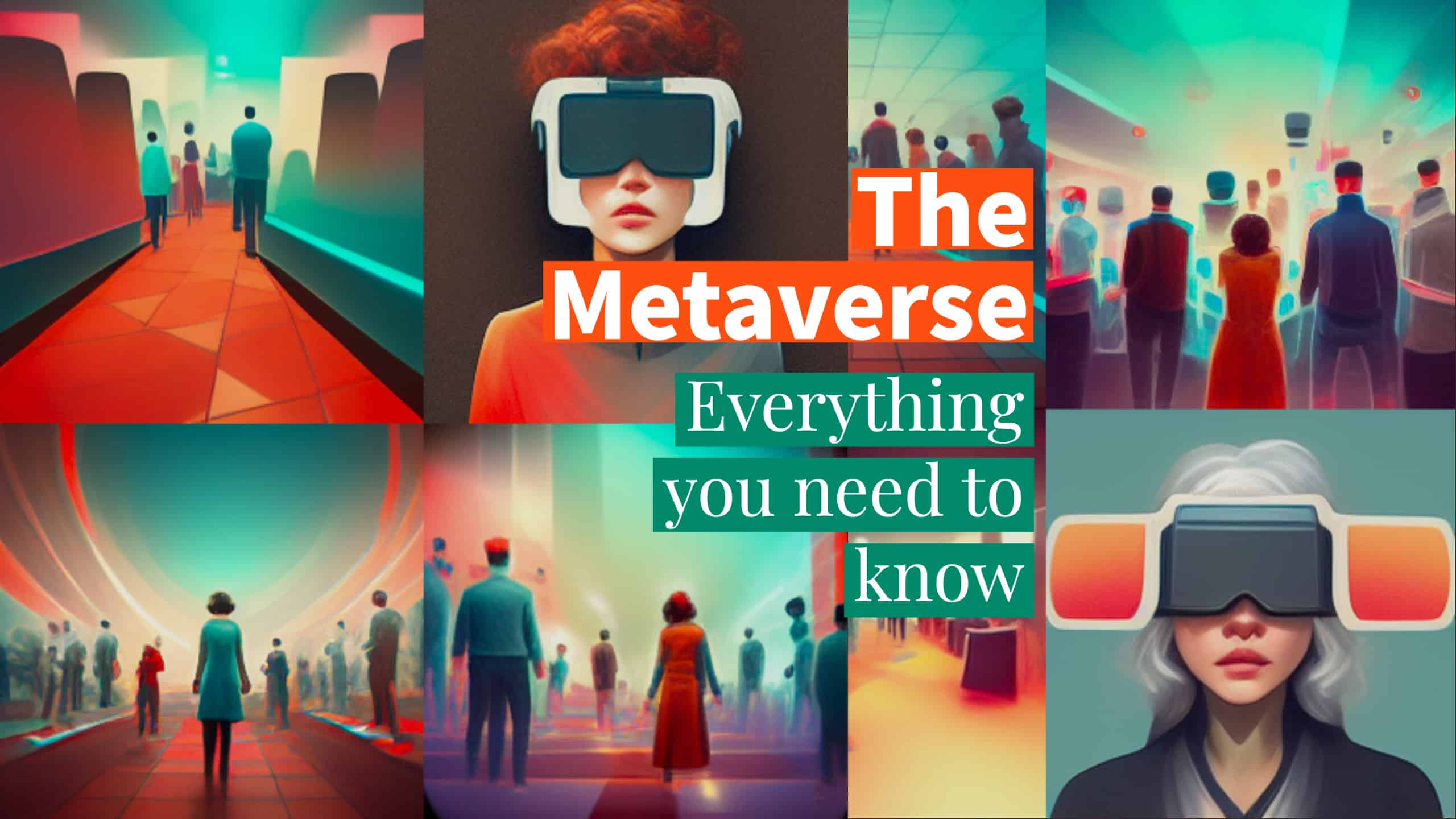Table of Contents
You may also interested:
In 2021, Mark Zuckerberg announced that Facebook would be changing its name to Meta. The name of the social media platform would still remain as Facebook, but the name of the parent company would be changed to Meta. He then declared that within five years, the company would move away from being a social media company to a “metaverse” one. Soon after, there was talk from various corners of the interwebs about a “metaverse”. Does the metaverse have something to do with Meta? And why is it so popular? Is it something that all of us can participate in? You might have read in the news that someone paid $450,000 to buy a virtual piece of land right beside Snoop Dogg’s own. Did that make sense to you? If you want to know more about this idea of a metaverse, read on.
What is Metaverse in simple terms?
The term metaverse is used to describe the concept of a virtual world that exists beyond the physical world. The metaverse is a collection of virtual worlds that are interconnected and can be accessed by anyone with an internet connection. The metaverse is a place where people can interact with each other and with digital objects in a virtual environment. The term was first coined by Neal Stephenson in his science fiction novel Snow Crash. The metaverse is also a platform for creating and sharing digital content.
So, what Metaverse really is?
Now, Mark Zukerberg himself didn’t coin the word “metaverse”. That word was invented by science fiction author Neal Stephenson way back in 1992. He coined this in his book “Snow Crash“, where he talked about a virtual city where people interact with each other in the same manner as they did in real life. They socialise, work and play in that virtual space just like how they would in the real world.
Zuckerberg’s statement did kickstart a frenzy of interest in this concept though. The folks that saw the greatest potential were the fine folks of web3, of course. They saw how blockchain technology could be coopted into this very idea of a metaverse, and the potential of digital currency to be used in the metaverse, as well as the buying and selling of virtual goods known as NFTs (non fungible tokens).
This leads me to my next point: There isn’t just one known metaverse. As of right now, there are at least three metaverses which are being popularly referred to in the web3 world, namely, Decentraland, The Sandbox and Cryptovoxels. And there are many more to come. Snoop Doog himself is reportedly starting a project to create his own Snoopverse, already having bought virtual land in other metaverses. Oh, and Stephenson himself is working on his own metaverse project called Lamina1. On top of that, many new NFT projects such as Degen Pass are promising metaverses for their communities in their roadmaps. And what of Meta’s metaverse? Oh, they have such plans too. It’s called Horizon Worlds.
So, what really is a metaverse? It is exactly how Neal Stephenson described it. A place where people can socialise, work and play with each other just like how they would in real life. Now, we already are doing that, to a large extent. Before the era of WhatsApp, people still used to make calls on their smartphones. Since 2009, with the invention of WhatsApp, people became gradually used to interacting with each other virtually using text, GIFs, stickers, graphics, videos and voice notes. Before Covid-19, working from home was so far away from the norm that it was considered unusual. During Covid-19, virtual meetings became the norm. Progressive-minded companies implemented systems to ensure that the workflow could be performed through virtual means, drastically reducing the need for face-to-face interaction. And way, way before that, computer games already had MUDs (multi-user dungeons) where players could get together and play the same level in the same game in real time (MUDs later gave way to a newer term: MMORPG (massive multi-player online role playing game)). So, since we’ve already been doing a lot of socialising, working and playing online already, what’s so special about the metaverse? Here’s how metaverses add on to the virtual experience:
- An immersive 3D world
- A digital currency
- Ownership of funds and properties recorded on Smart Contracts
An immersive 3D world
Remember Second life from the 1990s? It was a promising 3D world, with many organisations, notably universities establishing a virtual presence on the platform. Individuals too, participated actively on Second Life, creating an alternate reality for themselves. That’s how Metaverses look like, even though Second life itself is not considered a contemporary metaverse in the same vein as Decentraland and The Sandbox. Some metaverses may feature screen-based interfaces, like how one would take a tour of faraway lands on Google Earth. Other metaverses might feature virtual reality integration or even augmented reality integration (think Pokemon Go) to make the experience even more immersive.
So what can you possibly do here? Well, it depends on what that particular metaverse offers but, here’s some possibilities:
- Play games with others
- Buy tickets for a pay-per-view stream of a movie or sports event
- Invite others to visit your virtual house
- Shop for products in the real world
- Set up your own place of business
- And many more
A digital currency
Running around the metaverse can be exhausting. You might need a drink, some sick threads, some pumped up kicks, and maybe, in the future, a virtual roof over your virtual head. You are going to need some money to buy these things. This is where digital currency comes in. Now, this idea is not new. Freemium games have already done this decades ago, by allowing gamers to buy DLCs (downloadable content) in the form of gear, armour, weapons, credits and the like.
But what really gets web3 guys salivating is not just the idea of using money in the metaverse, but using crypto currency. You see, it is all fine and good to be able to purchase items using credit cards in such virtual wounds. But credit cards run on “fiat” (national currencies) and web3 guys have this weird love-hate relationship with fiat. On the one hand, the centralisation of fiat in the hands of national banks is something that web3 guys are against. In fact, Bitcoin itself was developed in the wake of the 2008 economic crisis. Bitcoin, and all other successive alt coins, saw that decentralising finance was the security the financial world needed. On the other hand, the volatility of decentralised finance over the past few years has led to some web3 developers creating stablecoins, coins which are pegged to fiat for less volatility in investment.
Whatever it might be, metaverses will use cryptocurrency for its financial transactions. You would need to buy a certain valve of that coin before you drop into that metaverse, either through paying for it using fiat, or using token (coin) exchange, assuming that the wallet you have and the metaverse wallet can be integrated.
Ownership of funds and properties recorded on Smart Contracts.
The third characteristic of metaverses that makes it such a web3 dream is its use of smart contracts. Now, smart contracts are encrypted records of ownership of funds and properties (inducing houses, vehicles and other digital implements within the metaverse). Smart contracts ensure that the three key pillars of blockchain technology are maintained, namely, immutability, traceability and transparency.
Whatever you own, be it a coin, an artwork or a virtual pet, is yours until you decide to sell or destroy (burn) It. The smart contract is immutable. It cannot be changed without your permission.
Whatever you buy, sell, or transfer can be traced to its rightful owner in the case of any dispute. Whatever you buy, sell or transfer can be seen by anyone. Transactions are thus transparent.
The metaverse is a logical evolution of the web3 space. With the ERC-20 standard, we were able to trade coins. With the ERC-721 and ERC-1155 standards, we were able to buy and sell NFTs. With NFT projects keeping their communities engaged through Discord and Twitter, wouldn’t you then want to have a permanent home on a metaverse for your project?






